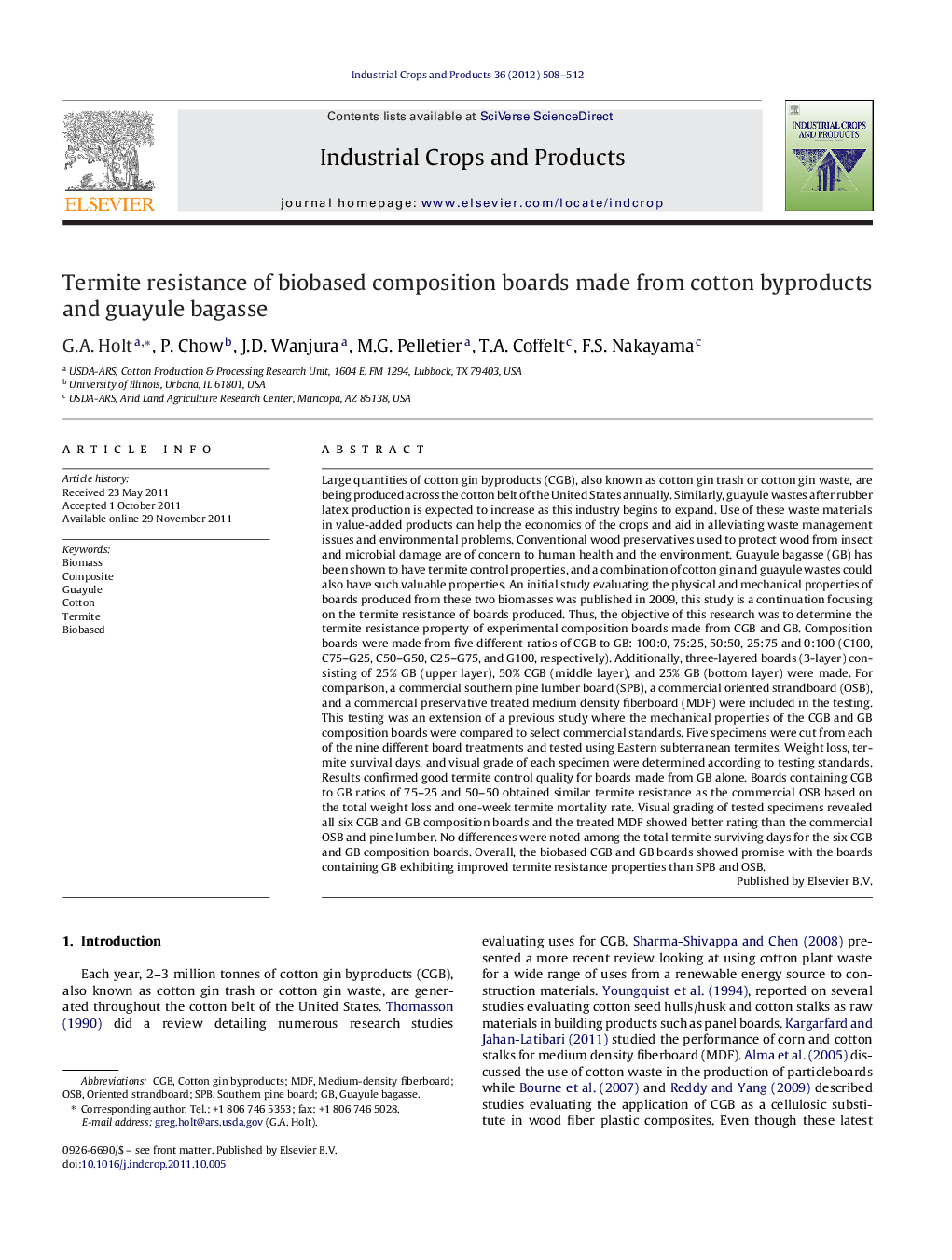| کد مقاله | کد نشریه | سال انتشار | مقاله انگلیسی | نسخه تمام متن |
|---|---|---|---|---|
| 4514416 | 1322209 | 2012 | 5 صفحه PDF | دانلود رایگان |

Large quantities of cotton gin byproducts (CGB), also known as cotton gin trash or cotton gin waste, are being produced across the cotton belt of the United States annually. Similarly, guayule wastes after rubber latex production is expected to increase as this industry begins to expand. Use of these waste materials in value-added products can help the economics of the crops and aid in alleviating waste management issues and environmental problems. Conventional wood preservatives used to protect wood from insect and microbial damage are of concern to human health and the environment. Guayule bagasse (GB) has been shown to have termite control properties, and a combination of cotton gin and guayule wastes could also have such valuable properties. An initial study evaluating the physical and mechanical properties of boards produced from these two biomasses was published in 2009, this study is a continuation focusing on the termite resistance of boards produced. Thus, the objective of this research was to determine the termite resistance property of experimental composition boards made from CGB and GB. Composition boards were made from five different ratios of CGB to GB: 100:0, 75:25, 50:50, 25:75 and 0:100 (C100, C75–G25, C50–G50, C25–G75, and G100, respectively). Additionally, three-layered boards (3-layer) consisting of 25% GB (upper layer), 50% CGB (middle layer), and 25% GB (bottom layer) were made. For comparison, a commercial southern pine lumber board (SPB), a commercial oriented strandboard (OSB), and a commercial preservative treated medium density fiberboard (MDF) were included in the testing. This testing was an extension of a previous study where the mechanical properties of the CGB and GB composition boards were compared to select commercial standards. Five specimens were cut from each of the nine different board treatments and tested using Eastern subterranean termites. Weight loss, termite survival days, and visual grade of each specimen were determined according to testing standards. Results confirmed good termite control quality for boards made from GB alone. Boards containing CGB to GB ratios of 75–25 and 50–50 obtained similar termite resistance as the commercial OSB based on the total weight loss and one-week termite mortality rate. Visual grading of tested specimens revealed all six CGB and GB composition boards and the treated MDF showed better rating than the commercial OSB and pine lumber. No differences were noted among the total termite surviving days for the six CGB and GB composition boards. Overall, the biobased CGB and GB boards showed promise with the boards containing GB exhibiting improved termite resistance properties than SPB and OSB.
► Termite resistance good for boards made from 100% guayule bagasse.
► Boards containing cotton gin byproducts to guayule bagasse ratios of 75–25 and 50–50 obtained similar termite resistance as the commercial OSB.
► Visual grading of tested specimens revealed all six cotton gin byproduct and guayule bagasse composition boards and the treated MDF showed better ratings than the commercial OSB and pine lumber.
► No differences were noted among the total termite surviving days for the six cotton gin byproduct and guayule bagasse composition boards.
Journal: Industrial Crops and Products - Volume 36, Issue 1, March 2012, Pages 508–512